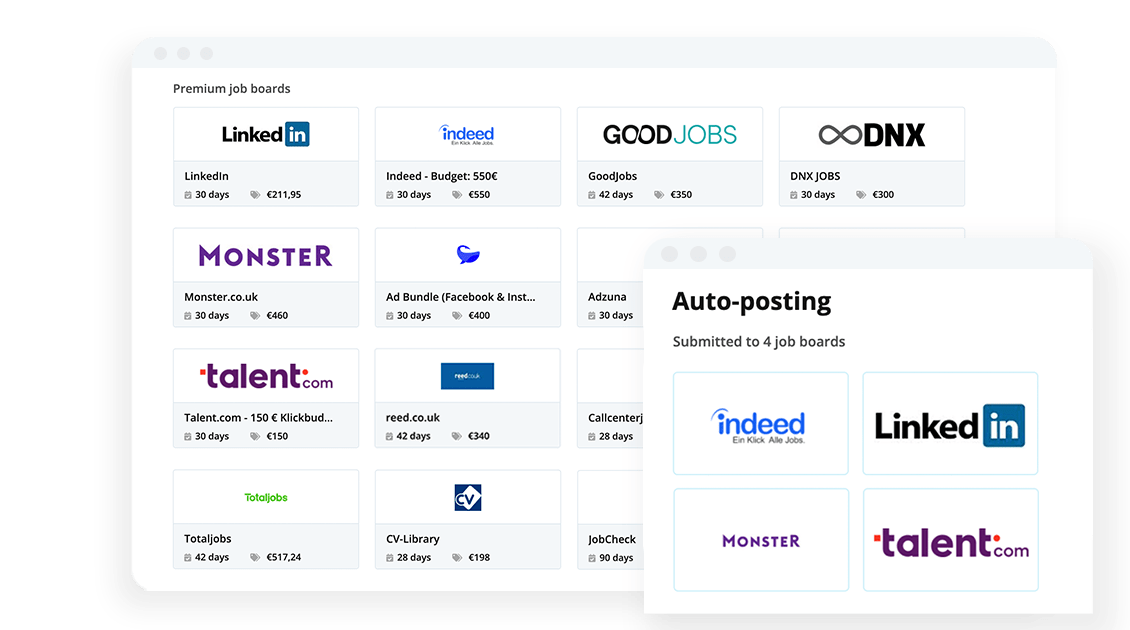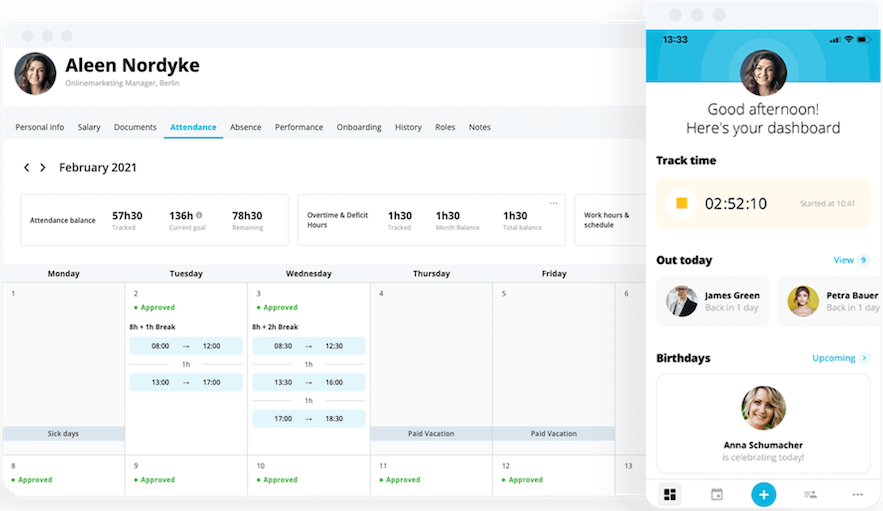What’s the Secret to Great Recruitment (HRM)?

How do recruitment tools and channels help you find top talent? After all, recruiting for a position isn't simply about filling it, it’s about finding the exact right person for the role.
In this article, we break down everything you need to know about the recruiting process, tips we think you will find helpful, and initiatives you can take to help bring your processes to the next level. It’s all here.
Find and hire top talent, all within Personio. Find out more today.What Is Recruitment?
Recruitment is the entire process behind sourcing, attracting, shortlisting, interviewing, signing, hiring, and onboarding new employees to your organisation. It’s the entire process governing how talent finds your brand, gets to know it through candidate experience and comes aboard as an employee (and all the tools involved in the process, too).
Best Practice: When it comes to recruiting, you absolutely need to have a varied approach to find success.
Recruiting software can play a key role here. It’s why companies invest so heavily in recruitment and HR software, to help optimise their processes in order to get better at sourcing and hiring the best talent.
How Does Recruitment Differ From Hybrid Recruitment?
The recruiting process includes both online and offline recruiting initiatives. Hybrid recruitment, on the other hand, is a subset of recruitment focusing on online activities alone. Both the search for candidates and applicant management and communication are carried out digitally in e-recruiting.
What Are the 6 Phases of the Recruiting Process?
Whether we think of them as phases or recruitment tools, these are all the methods an organisation can use to find, vet and lock down top talent:
Phase | Explained |
|---|---|
Job Adverts | Building the perfect description. |
Publication | Sharing the message more widely. |
Shortlisting | Compiling a list of top talent. |
Interviews | Speaking to candidates and learning more. |
Applicant Evaluation | Making a decision about who fits best. |
Contract Signing & Onboarding | Getting the ink dry on all the paperwork. |
Let’s break each down a bit more…
Job adverts – It all starts with a proper job advert! That’s why HR and specialist departments need to put their heads together to craft the perfect job description.
Publication – The open position is then shared widely via the company website, job portals, social media, active sourcing and any other relevant channels.
Shortlisting – This is typically carried out by HR, whether using or not using tools typically used to filter candidates on the basis of clearly-defined criteria.
Interviews – The next step involves meeting the candidates and – depending on the role – testing them out. This might involve a structured interview or a semi-structured interview.
Applicant Evaluation – When it comes to the evaluation, HR has to guarantee two things: that it can proceed quickly – there is nothing applicants hate more than having to wait – and that everything is done professionally. Professionalism means creating objective criteria, involving the right colleagues and making transparent decisions.
Contract Signing & The best-case scenario is that the candidate accepts the position, and HR can start preparing for their induction.
What Is an Example of a Positive Recruiting Process?
If you take the entire recruiting process listed above, you can bolster it with data, automation and a well-defined process. For example, really drilling down and creating a job advert template that maintains consistency across departments, or finessing an interview process that challenges candidates at each stage (whether about skills, cultural fit, or values).
Moreover, a great recruiting process relies on this concept of candidate experience. In a war for talent, the candidate always needs to be at the centre of your universe. So, your entire process, even the way you speak to them or respond to their questions, needs to be streamlined (and, ideally, automated as a workflow).
But, you can only determine if a candidate is right for your role if you have candidates in the first place. So, the trick becomes sourcing, attracting, and shortlisting the most qualified candidates.
Here’s how we’d break it down:
Examples of Internal Recruiting Initiative
Sometimes a solution is closer than you think. When it comes to recruitment, this is quite literally true. Because a position can also be filled by an existing employee.
1. Advertising Positions Internally
With an internal job advertisement, you can focus on your colleagues within the company. This has advantages for both sides: In the best-case scenario, you do not have to spend a long time looking for the right candidate, and you already know your ‘new’ employee.
From the employee’s point of view, new career prospects open up. This may involve a new professional focus, a promotion, more responsibility, or a higher salary. However, there is one clear disadvantage: You will have to find someone to take over the employee’s old position (dive deeper: Succession planning).
2. Transfers
A new location, a new department or new tasks. Transferring employees can be a way of managing your workforce planning needs. But, exercise caution: What may seem to be an appropriate course of action from the employer’s point of view can be very stressful for employees.
Involve your employee in any transfer decisions and do not make them over their head. Otherwise, you risk creating demotivated and unproductive employees.
Find Top Talent Across 500+ Job Portals

Publish job ads on over 500 job portals with one click. Then, monitor each channels’ performance – all available within Personio’s recruiting software.
Learn more todayExamples of External Recruiting Initiative
External recruiting is designed to address people outside your organisation. To do so, you can take an active or a passive approach.
1. Unsolicited Applications
Candidates apply for a fictitious position that has not been advertised. All you have to do is process the applications. There is no need for the recruitment stage in this process.
2. Talent Pools
Consider talent pools as your in-house database of existing and potential candidates.In general, though, you can draw suitable applicants from them as needed.
3. Employer Branding
Employer branding straddles the divide between active and passive approaches. It makes you, as a company, more attractive to applicants (passive). However, to accomplish this, you need to strengthen your brand (active).
Download our complete eBook to boosting your employer brand.
4. Job Adverts
The advertisement for your vacancy. Job ads are the classic way to reach potential applicants – whether online or offline.
5. Social Media Recruiting
Social media recruiting has two aspects: First, companies can post ads for open positions on social networks. Second, social networks are a great way to actively contact potential candidates (active sourcing).
6. Recruiting Events
These include career fairs, internal recruiting events, and campus marketing.
Recruitment Tools & Channels: An Overview
What are some of the most popular recruitment tools on the market? Here’s our easy breakdown:
Channel | Defined |
|---|---|
Career Website | According to one study, almost 40% of all jobs are filled through the career website. Make sure it is clear and easy to follow so that potential applicants can quickly find what is most relevant to them. |
Job Portals | There are numerous job portals out there. Which platform you choose for your recruitment depends on the target group. Typically, using a combination of platforms is usually the best option. |
Social Media | Social media also has the advantage of attracting the attention of potential candidates who are not actively looking for work. Whether that is through advertisements or a personal approach from a recruiter, headhunter, specialist, or a contact. |
Mobile Recruiting | According to Monster, 90% of companies said that mobile recruiting (recruiting via smartphones, tablets etc.) is becoming increasingly important. So, a mobile-optimized career page is mandatory in this case. |
Career Fairs | Show this sought-after new generation of talent what you have to offer as an employer and why exactly they should start their careers with you. |
Employee Referrals | When employees suggest open positions to their contacts or acquaintances, this has two advantages: It is more cost-effective and it ties potential candidates more closely to the company (from the very beginning). |
Which Recruitment Channels Work Best?
Job advertisements or headhunters? Search online or in print media? Invest more in
Nowadays, recruiting options are endless. The important thing is to do the math: How much are you paying for your recruiting initiatives and what is the unfilled position costing you (cost of vacancy)?
The recruitment agency Perspectivas presents a calculation from a study by Harvard University. It assumes the following: Depending on the position, each employee contributes to company turnover by a factor of one to three. Each company specifies the factor for the respective job.
Attract Talent Through Employer Branding

Download our complete eBook on the topic of employer branding to see how it can unlock your talent sourcing efforts in new and exciting ways.
Download For FreeWhat is the Future of Recruitment?
The competitive labour market also calls for a strategic rethink on the part of recruiters, because you need to (re)fill positions even more quickly.
Recruiters should try and keep the following in mind:
1. Get Up Close and Personal
Recruiters should – quite literally – be more visible. That means more personal and individual communication with candidates because candidate expectations have changed. Communication has to take place on an equal footing rather than coming down from on high, as was the case for so long.
2. Build a Network
Making things more personal also means building up a broad network and staying in touch with your contacts – and potential candidates. Social media is perfect for this. If recruiters are able to establish an (emotional) connection with their followers, this will be a great help during the recruiting process.
3. Make Your Data Work Harder
Even the best recruiting processes require data and recruiting software. In addition to evaluating which components, phrases (for example using A/B testing), and job advertisement channels are most successful, aspects such as time-to-hire and the website visitor-to-applicants rate should be analysed regularly.
That is why one of the best recruiting tips is having the infrastructure in place to facilitate the delivery of data. That way, you have fresh insights, at a glance, and only at the click of a button. Your data works harder for you, and you spend less time putting it together.
4. Sensitive Selection
The trend is moving away from quantity toward quality. It is not the number of applicants that matters, but how good a fit they are for the job and the company, and how long they stay. It should not make any difference to recruiters if developers make spelling mistakes in their applications. What matters are their abilities.
Marketing managers, on the other hand, should be able to sell themselves effectively and should not submit a run-of-the-mill application. So, it is even more important for recruiters to understand their target group.
5. Focus on Cultural Fit
What is recruitment? At its heart, what matters is a shared understanding of topics such as how to deal with clients, work ethic, and feedback (just to name a few). So, if you make sure before the hiring that the applicant and company are a good cultural fit, it will pay dividends in terms of employee loyalty and company success.
Can HR Software Unlock Your Recruiting Efforts?
Using Personio, you can manage and control jobs and applicants with a single tool. Rather than having multiple Excel spreadsheets that are vulnerable to errors, all your information is streamlined, seamless and accessible.
It’s also easier than you think to analyse and evaluate your recruiting initiatives. You can do it all, at the click of a button, to ensure that your recruiting is as successful as possible. We can help.


